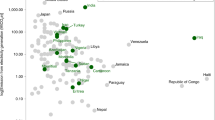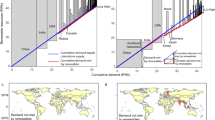Abstract
Climate-induced extreme weather conditions make electricity infrastructure more vulnerable. They increase the risk of power-line-ignited wildfires which can, in turn, jeopardize electric power delivery. Here, leveraging machine learning, we show that lower-income communities in California not only have lower fractions of power distribution lines undergrounded, but overhead lines and poles in their neighbourhoods are also more vulnerable to wildfires. Should they bear the cost of undergrounding fire-prone lines themselves, they would have to pay a disproportionately higher cost per household. We propose a cost allocation scheme with an income threshold below which the cost is borne by utility-wide ratepayers and above which the cost is borne locally. This scheme can not only minimize the average of undergrounding costs per household as a share of income, but also homogenize such cost–income ratios across communities. Our research demonstrates the opportunity to appropriately integrate existing policies to make electricity infrastructure affordable, equitable and reliable amidst climate change.
This is a preview of subscription content, access via your institution
Access options
Access Nature and 54 other Nature Portfolio journals
Get Nature+, our best-value online-access subscription
$29.99 / 30 days
cancel any time
Subscribe to this journal
Receive 12 digital issues and online access to articles
$119.00 per year
only $9.92 per issue
Buy this article
- Purchase on Springer Link
- Instant access to full article PDF
Prices may be subject to local taxes which are calculated during checkout





Similar content being viewed by others
Data availability
The data utilized or generated in this study have been deposited in figshare, available at https://doi.org/10.6084/m9.figshare.23423051. Raw data of tree canopy can be obtained from https://forestobservatory.com. Grid data can be obtained from https://www.pge.com/en_US/for-our-business-partners/distribution-resource-planning/distribution-resource-planning-data-portal.page and https://drpep.sce.com/drpep. ACS data can be downloaded from https://www.socialexplorer.com. Solar installation data can be downloaded from https://deepsolar.web.app.
Code availability
Code scripts were developed in Python (v.3.6). The source code is available at https://github.com/wangzhecheng/vulnerability. Required Python packages and their version numbers include: numpy (v.1.19.5), scipy (v.1.1.0), Pillow (v.5.2.0), pandas (v.0.24.2), shapely (v.1.7.1), geopandas (v.0.8.2), geojson (v.2.5.0), scikit-learn (v.0.24.2), statsmodels (v.0.9.0), plotly (v.4.14.3), pyshp (v.2.1.2), torch (v.1.1.0) and torchvision (v.0.2.2).
References
Dale, L., Carnall, M., Wei, M., Fitts, G. & McDonald, S. L. Assessing the Impact of Wildfires on the California Electricity Grid. Report No. CCCA4-CEC-2018-002 (California Energy Commission, 2018).
Arab, A., Khodaei, A., Eskandarpour, R., Thompson, M. P. & Wei, Y. Three lines of defense for wildfire risk management in electric power grids: a review. IEEE Access 9, 61577–61593 (2021).
Dennison, P. E., Brewer, S. C., Arnold, J. D. & Moritz, M. A. Large wildfire trends in the western United States, 1984–2011. Geophys. Res. Lett. 41, 2928–2933 (2014).
McWethy, D. B. et al. Rethinking resilience to wildfire. Nat. Sustain. 2, 797–804 (2019).
Syifa, M., Panahi, M. & Lee, C. W. Mapping of post-wildfire burned area using a hybrid algorithm and satellite data: the case of the camp fire wildfire in California, USA. Remote Sens. 12, 623 (2020).
Muhs, J. W., Parvania, M. & Shahidehpour, M. Wildfire risk mitigation: a paradigm shift in power systems planning and operation. IEEE Open Access J. Power Energy 7, 366–375 (2020).
Collins, K. M., Penman, T. D. & Price, O. F. Some wildfire ignition causes pose more risk of destroying houses than others. PLoS ONE 11, e0162083 (2016).
Jazebi, S., De Leon, F. & Nelson, A. Review of wildfire management techniques—part I: causes, prevention, detection, suppression, and data analytics. IEEE Trans. Power Deliv. 35, 430–439 (2019).
Keeley, J. E. & Syphard, A. D. Historical patterns of wildfire ignition sources in California ecosystems. Int. J. Wildland Fire 27, 781–799 (2018).
Ma, J. et al. Real-time detection of wildfire risk caused by powerline vegetation faults using advanced machine learning techniques. Adv. Eng. Inf. 44, 101070 (2020).
2021 incident archive. CAL FIRE https://www.fire.ca.gov/incidents/2021 (2021).
2018 incident archive. CAL FIRE https://www.fire.ca.gov/incidents/2018 (2018).
Cordova, G. CAL FIRE investigators point to tree hitting PG&E power lines as cause of Dixie fire. ABC10 https://www.abc10.com/article/news/local/wildfire/dixie-fire-cause-pacific-gas-and-electric/103-03d568e1-b141-48a1-9579-713688a71826 (2022).
Eavis, P. & Penn, I. California says PG&E power lines caused Camp Fire that killed 85. The New York Times https://www.nytimes.com/2019/05/15/business/pge-fire.html (2019).
Choobineh, M., Ansari, B. & Mohagheghi, S. Vulnerability assessment of the power grid against progressing wildfires. Fire Saf. J. 73, 20–28 (2015).
Bagchi, A., Sprintson, A. & Singh, C. Modeling the impact of fire spread on the electrical distribution network of a virtual city. In 41st North American Power Symposium 1–6 (IEEE, 2009).
2019 PSPS Event –Wildfire Analysis Report. California Public Utilities Commission https://www.cpuc.ca.gov/-/media/cpuc-website/divisions/safety-and-enforcement-division/documents/technosylva-report-on-pge-psps-eventoct-2629-2019.pdf (2021).
Abatzoglou, J. T. & Williams, A. P. Impact of anthropogenic climate change on wildfire across western US forests. Proc. Natl Acad. Sci. USA 113, 11770–11775 (2016).
Williams, A. P. et al. Observed impacts of anthropogenic climate change on wildfire in California. Earth’s Future 7, 892–910 (2019).
Ozansoy, C. & Gomes, D. P. Volatility diagnosis in phase-to-phase fault detection for branch across wire faults. IEEE Trans. Power Deliv. 36, 19–29 (2020).
Mills, S. J. et al. Evaluation of aerial remote sensing techniques for vegetation management in power-line corridors. IEEE Trans. Geosci. Remote Sens. 48, 3379–3390 (2010).
McGranaghan, M., Olearczyk, M. & Gellings, C. Enhancing distribution resiliency: opportunities for applying innovative technologies. Electr. Today 28, 46–48 (2013).
Abatzoglou, J. T., Smith, C. M., Swain, D. L., Ptak, T. & Kolden, C. A. Population exposure to pre-emptive de-energization aimed at averting wildfires in Northern California. Environ. Res. Lett. 15, 094046 (2020).
Taylor, W. O., Watson, P. L., Cerrai, D. & Anagnostou, E. A statistical framework for evaluating the effectiveness of vegetation management in reducing power outages caused during storms in distribution networks. Sustainability 14, 904 (2022).
Hall, K. L. Out of Sight, Out of Mind 2012: An Updated Study on the Undergrounding of Overhead Power Lines (Edison Electric Institute, 2013).
Deegan, C. Environmental costing in capital investment decisions: electricity distributors and the choice of power poles. Aust. Account. Rev. 18, 2–15 (2008).
Wong-Parodi, G. When climate change adaptation becomes a “looming threat” to society: exploring views and responses to California wildfires and public safety power shutoffs. Energy Res. Soc. Sci. 70, 101757 (2020).
Mildenberger, M., Howe, P. D., Trachtman, S., Stokes, L. C. & Lubell, M. The effect of public safety power shut-offs on climate change attitudes and behavioural intentions. Nat. Energy 7, 736–743 (2022).
Kousky, C., Greig, K., Lingle, B. & Kunreuther, K. Wildfire cost in California: the role of electric utilities (The Wharton Risk Management and Decision Processes Center, 2018); https://riskcenter.wharton.upenn.edu/wp-content/uploads/2018/08/Wildfire-Cost-in-CA-Role-of-Utilities-1.pdf
Syphard, A. D. & Keeley, J. E. Location, timing and extent of wildfire vary by cause of ignition. Int. J. Wildland Fire 24, 37–47 (2015).
Jazebi, S., De Leon, F. & Nelson, A. Review of wildfire management techniques—part II: urgent call for investment in research and development of preventative solutions. IEEE Trans. Power Deliv. 35, 440–450 (2019).
Fenrick, S. A. & Getachew, L. Cost and reliability comparisons of underground and overhead power lines. Util. Policy 20, 31–37 (2012).
Phase 1 decision revising electric rule 20 and enhancing program oversight. California Public Utility Commission https://docs.cpuc.ca.gov/PublishedDocs/Published/G000/M387/K099/387099230.PDF (2021).
CPUC Rule 20 Undergrounding Programs–FAQs. California Public Utility Commission https://www.cpuc.ca.gov/industries-and-topics/electrical-energy/infrastructure/electric-reliability/undergrounding-program-description/cpuc-rule-20-undergrounding-programs----faqs (accessed 19 September 2022).
Undergrounding electric overhead lines. Pacific Gas and Electric Company https://www.pge.com/en_US/residential/customer-service/other-services/electric-undergrounding-program/electric-undergrounding-program.page (accessed 17 August 2022).
Cost sharing for underground lines. Hawaiian Electric https://www.hawaiianelectric.com/about-us/power-facts/undergrounding-utility-lines/cost-sharing-for-underground-lines (accessed 17 August 2022).
Yao, M., Bharadwaj, M., Zheng, Z., Jin, B. & Callaway, D. S. Predicting electricity infrastructure induced wildfire risk in California. Environ. Res. Lett. 17, 094035 (2022).
Sathaye, J. et al. Estimating Risk to California Energy Infrastructure from Projected Climate Change. Report No. CEC-500-2011-XXX (California Energy Commission, 2011).
Dumas, M., Kc, B. & Cunliff, C. I. Extreme Weather and Climate Vulnerabilities of the Electric Grid: A Summary of Environmental Sensitivity Quantification Methods. No. ORNL/TM-2019/1252 (Oak Ridge National Lab, 2019).
Trakas, D. N. & Hatziargyriou, N. D. Optimal distribution system operation for enhancing resilience against wildfires. IEEE Trans. Power Syst. 33, 2260–2271 (2017).
Kono, T., Sega, K. & Seya, H. Estimating the willingness to pay for undergrounding utility lines in Japan with the hedonic approach. SSRN https://doi.org/10.2139/ssrn.3039997 (2017).
Barreca, A., Park, R. J. & Stainier, P. High temperatures and electricity disconnections for low-income homes in California. Nat. Energy 7, 1052–1064 (2022).
Sánchez, J. J., Holmes, T. P., Loomis, J. & González-Cabán, A. Homeowners willingness to pay to reduce wildfire risk in wildland urban interface areas: implications for targeting financial incentives. Int. J. Disaster Risk Reduct. 68, 102696 (2022).
A statewide tree-level forest monitoring system. California Forest Observatory https://forestobservatory.com (2020).
Seidel, M. What is the standard height of power lines? Legal Beagle https://legalbeagle.com/7623705-standard-height-power-lines.html (2019).
Islam, M. & Greg, H. Methods to reduce the risk of wooden pole ignition. Electr. Power Syst. Res. 134, 213–221 (2016).
Borenstein, S., Fowlie, M. & Sallee, J. Designing electricity rates for an equitable energy transition. Energy Institute at Haas https://haas.berkeley.edu/wp-content/uploads/WP314.pdf (2021).
CARE/FERA Program. California Public Utilities Commission https://www.cpuc.ca.gov/industries-and-topics/electrical-energy/electric-costs/care-fera-program (accessed 17 August 2022).
American Community Survey (ACS) 2015–2019 5-Year Estimates (US Census Bureau, 2020).
Mann, M. L. et al. Incorporating anthropogenic influences into fire probability models: effects of human activity and climate change on fire activity in California. PLoS ONE 11, e0153589 (2016).
Fire probability for carbon accounting. CAL FIRE https://frap.fire.ca.gov/frap-projects/fire-probability-for-carbon-accounting (accessed 25 February 2021).
Distributed Resource Planning (DRP) data and maps. Pacific Gas and Electric Company https://www.pge.com/en_US/for-our-business-partners/distribution-resource-planning/distribution-resource-planning-data-portal.page (accessed 19 February 2021).
Distributed Resources Plan (DRP) External Portal. Southern California Edison https://drpep.sce.com/drpep (accessed 2 April 2021).
PG&E Electric Distribution Geographical Information System. California Public Utilities Commission https://pspsinfo.ss.pge.com/rr/artifacts/wildfire-mitigation-data/Attachment-6-GIS-Files.zip (accessed 2 August 2022).
Wilson, J. Why not bury California’s fire-prone power lines underground? The reason is sky high. Desert Sun https://www.desertsun.com/story/news/environment/2019/10/11/cost-to-bury-california-fire-prone-power-lines-why-not/3937653002 (2019).
Yu, J., Wang, Z., Majumdar, A. & Rajagopal, R. DeepSolar: a machine learning framework to efficiently construct a solar deployment database in the United States. Joule 2, 2605–2617 (2018).
McCarthy, K. Undergrounding Electric Lines. OLR Research Report 2011–R–0338 (Connecticut General Assembly, 2011).
Szegedy, C., Vanhoucke, V., Ioffe, S., Shlens, J. & Wojna, Z. Rethinking the inception architecture for computer vision. In Proc. IEEE Conference on Computer Vision and Pattern Recognition 2818–2826 (IEEE, 2016).
Acknowledgements
This work was funded in part by the US Department of Energy’s Office of Energy Efficiency and Renewable Energy under the Solar Energy Technologies Office Fiscal Year 2020 Funding Program (award number DE-EE0009359) to R.R. and A.M., and by a Stanford Precourt Pioneering Project award to R.R. and A.M. The views and opinions expressed by the authors do not necessarily state or reflect those of the funding sources.
Author information
Authors and Affiliations
Contributions
Z.W., M.W., A.M. and R.R. conceptualized the research. Z.W. developed the methodology and analysed the data. Z.W. wrote the initial paper draft. M.W. deepened the policy insight. Z.W., M.W., A.M. and R.R. edited and revised the paper. A.M. and R.R. provided funding acquisition support for the research.
Corresponding authors
Ethics declarations
Competing interests
The authors declare no competing interests.
Peer review
Peer review information
Nature Energy thanks Daniel Farber, Line Roald and Qianru Zhu for their contribution to the peer review of this work.
Additional information
Publisher’s note Springer Nature remains neutral with regard to jurisdictional claims in published maps and institutional affiliations.
Supplementary information
Supplementary Information
Supplementary Notes 1–4, Figs. 1–23 and Table 1.
Rights and permissions
Springer Nature or its licensor (e.g. a society or other partner) holds exclusive rights to this article under a publishing agreement with the author(s) or other rightsholder(s); author self-archiving of the accepted manuscript version of this article is solely governed by the terms of such publishing agreement and applicable law.
About this article
Cite this article
Wang, Z., Wara, M., Majumdar, A. et al. Local and utility-wide cost allocations for a more equitable wildfire-resilient distribution grid. Nat Energy 8, 1097–1108 (2023). https://doi.org/10.1038/s41560-023-01306-8
Received:
Accepted:
Published:
Issue Date:
DOI: https://doi.org/10.1038/s41560-023-01306-8
This article is cited by
-
Sharing the cost of wildfire resilience
Nature Energy (2023)



